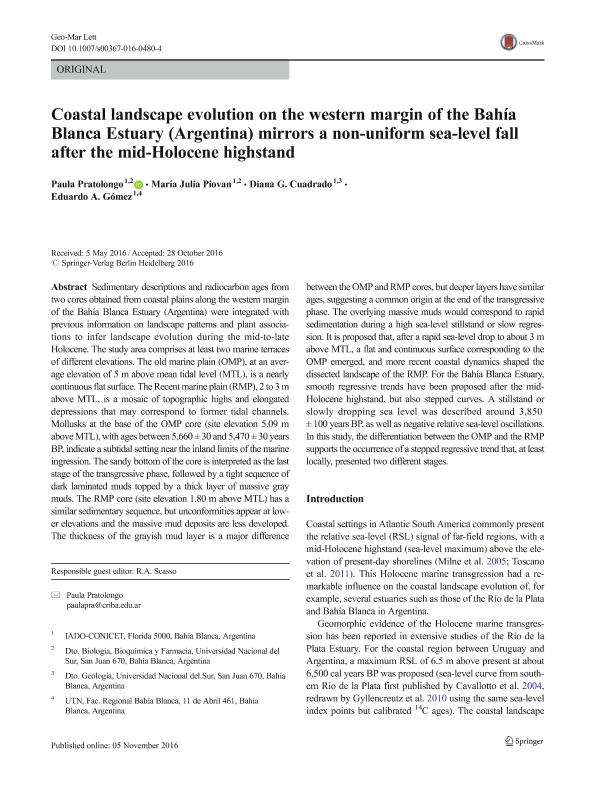Artículo
Coastal landscape evolution on the western margin of the Bahía Blanca Estuary (Argentina) mirrors a non-uniform sea-level fall after the mid-Holocene highstand
Fecha de publicación:
11/2016
Editorial:
Springer
Revista:
Geo-marine Letters
ISSN:
0276-0460
Idioma:
Inglés
Tipo de recurso:
Artículo publicado
Clasificación temática:
Resumen
Sedimentary descriptions and radiocarbon ages from two cores obtained from coastal plains along the western margin of the Bahía Blanca Estuary (Argentina) were integrated with previous information on landscape patterns and plant associations to infer landscape evolution during the mid-to-late Holocene. The study area comprises at least two marine terraces of different elevations. The old marine plain (OMP), at an average elevation of 5 m above mean tidal level (MTL), is a nearly continuous flat surface. The Recent marine plain (RMP), 2 to 3 m above MTL, is a mosaic of topographic highs and elongated depressions that may correspond to former tidal channels. Mollusks at the base of the OMP core (site elevation 5.09 m above MTL), with ages between 5,660 ± 30 and 5,470 ± 30 years BP, indicate a subtidal setting near the inland limits of the marine ingression. The sandy bottom of the core is interpreted as the last stage of the transgressive phase, followed by a tight sequence of dark laminated muds topped by a thick layer of massive gray muds. The RMP core (site elevation 1.80 m above MTL) has a similar sedimentary sequence, but unconformities appear at lower elevations and the massive mud deposits are less developed. The thickness of the grayish mud layer is a major difference between the OMP and RMP cores, but deeper layers have similar ages, suggesting a common origin at the end of the transgressive phase. The overlying massive muds would correspond to rapid sedimentation during a high sea-level stillstand or slow regression. It is proposed that, after a rapid sea-level drop to about 3 m above MTL, a flat and continuous surface corresponding to the OMP emerged, and more recent coastal dynamics shaped the dissected landscape of the RMP. For the Bahía Blanca Estuary, smooth regressive trends have been proposed after the midHolocene highstand, but also stepped curves. A stillstand or slowly dropping sea level was described around 3,850 ± 100 years BP, as well as negative relative sea-level oscillations. In this study, the differentiation between the OMP and the RMP supports the occurrence of a stepped regressive trend that, at least locally, presented two different stages.
Palabras clave:
Holocene Trangresion
,
Recent Marine Plain
,
Sediment Core
Archivos asociados
Licencia
Identificadores
Colecciones
Articulos(IADO)
Articulos de INST.ARG.DE OCEANOGRAFIA (I)
Articulos de INST.ARG.DE OCEANOGRAFIA (I)
Citación
Pratolongo, Paula Daniela; Piovan, María Julia; Cuadrado, Diana Graciela; Gomez, Eduardo Alberto; Coastal landscape evolution on the western margin of the Bahía Blanca Estuary (Argentina) mirrors a non-uniform sea-level fall after the mid-Holocene highstand; Springer; Geo-marine Letters; 37; 4; 11-2016; 12-24
Compartir
Altmétricas




